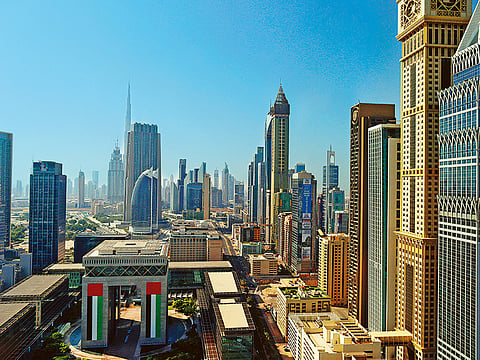Explainer: Key boosters for UAE’s GDP growth
Direct government spending growth vital for recovery

UAE's recent moves related to various economic support packages include:
■ Sweeping visa, labour policy changes
■ Moves to support small and medium enterprises (SMEs)
■ Programmes to boost population and employment growth
■ Strengthening the investment environment
Dubai: The UAE government’s recent move to expand public spending in the context of improving oil prices will be central to the rebound in economic growth this year and next, said analysts.
Abu Dhabi and Dubai have announced broad-based packages to bolster economic activity, highlighting the proactive nature of the government in supporting the growth outlook in both the short and the longer term.
Fiscal policy
According to a recent report from ADCB’s economic research team, more accommodative fiscal policy will be positive for real non-oil GDP growth.
There have already been a number of announcements related to various economic support packages, including programmes for boosting the population and employment growth, those supporting small and medium enterprises (SMEs), reducing business costs and strengthening the investment environment.
“We believe that these [fiscal] reforms will help reduce some short-term cost pressures on corporates and help to strengthen the competitiveness of the economy, which will be positive for the medium-term outlook,” said Monica Malik, Chief Economist of ADCB.
Growth forecast
Recent revised economic forecast on the UAE from the International Monetary Fund (IMF) and the Institute of International Finance (IIF) showed significant improvement in their GDP forecast for 2018 and 2019.
The UAE economic growth is expected to strengthen over the next few years on higher oil prices and increased government spending, the IMF said in a statement following the latest Article IV consultation.
The IMF team observed that the UAE needs more fiscal easing in the near term and once the recovery gains momentum the government could return to a path of gradual and growth-friendly fiscal consolidation.
“The UAE economy continues to adjust to a prolonged decline in oil prices since 2014," said Natalia Tamirisa, the IMF team leader of the 2018 Article IV Consultation.
"Non-oil activity remains subdued amid continued corporate restructuring, real estate overhang, and tightening financial conditions," she added.
"With oil production and government spending set to rise, overall growth is projected to strengthen to 2.9 per cent this year and 3.7 per cent next year,” said Tamirisa.
UAE growth
The UAE’s inflation is projected at 3.5 per cent this year owing to the introduction of the value-added tax and should ease afterwards.
The fiscal deficit is expected to remain stable at about 1.6 per cent of GDP this year and turn to a surplus next year.
The current account surplus will exceed 7 per cent of GDP this year.
“Given large fiscal buffers, ample spare capacity, and rising investment needs for Expo 2020, the government has appropriately switched to providing stimulus to the economy," said Tamirisa.
"Front-loading stimulus measures and focusing them on productive spending, consistent with the Vision 2021 goals of diversifying the economy and raising productivity, would augment their impact on growth,” she added.
A strongly expansionary federal budget has been approved for 2019 with a total spending of Dh60.3 billion up 17.3 per cent year on year, up from 5.5 per cent higher spending for 2018 and 3.6 per cent in 2017.
“The UAE federal budget tends to account for around 14 per cent of consolidated fiscal spending, though it still indicates a shift to a more accommodative fiscal position,” said Malik.
The IIF has forecast a substantially improved economic outlook for the UAE on the back of higher oil prices and fiscal easing.
“We expect growth to pick up from 0.8 per cent in 2017 to 2.5 per cent in 2018, supported by the modest increase in oil production and fiscal stimulus. Growth in Abu Dubai is expected to be higher than in Dubai, due to higher oil prices and the substantial increase in public spending,” said Garbis Iradian, Chief Economist, Mena of IIF.
According to ADCB economists the non-oil growth likely bottomed in 2017 and 2018 and therefore expects some strengthening of real non-oil GDP growth in the UAE in 2019 as the drag from the introduction of VAT wanes, the investment programme gathers momentum, and a more expansionary fiscal position is adopted.
“We do not expect to see any new major fiscal reform measures to boost government revenues in the outlook period with policy instead shifting towards supporting growth and away from consolidation," she said.
"The forecast return to a fiscal surplus in 2018 and the fiscal adjustment already implemented are supportive of this shift, in our view. We also see the government’s investment programme supporting growth over the outlook period,” said Thirumalai Nagesh, an economist at ADCB.
Liquid banking sector to support growth
Dubai: Highly liquid banks can play a big role in the UAE’s economic growth, according to the Institute of International Finance. Banks remain adequately capitalised with a 16.3 per cent Tier 1 ratio in June 2018, the eligible liquid asset ratio for national banks has increased, and the loan-to-deposit ratio edged down to 96 per cent in July 2018.
However, NPLs as a share of total loans remain relatively high at 6.7 per cent. The net interest margin has improved, as loans reset at higher rates and funding costs improved as liquidity conditions eased.
While a modest acceleration in growth in deposits and credit to 6.5 per cent and 4.2 per cent, respectively, funding costs too are expected to increase with the Fed rate hikes.
Sign up for the Daily Briefing
Get the latest news and updates straight to your inbox



